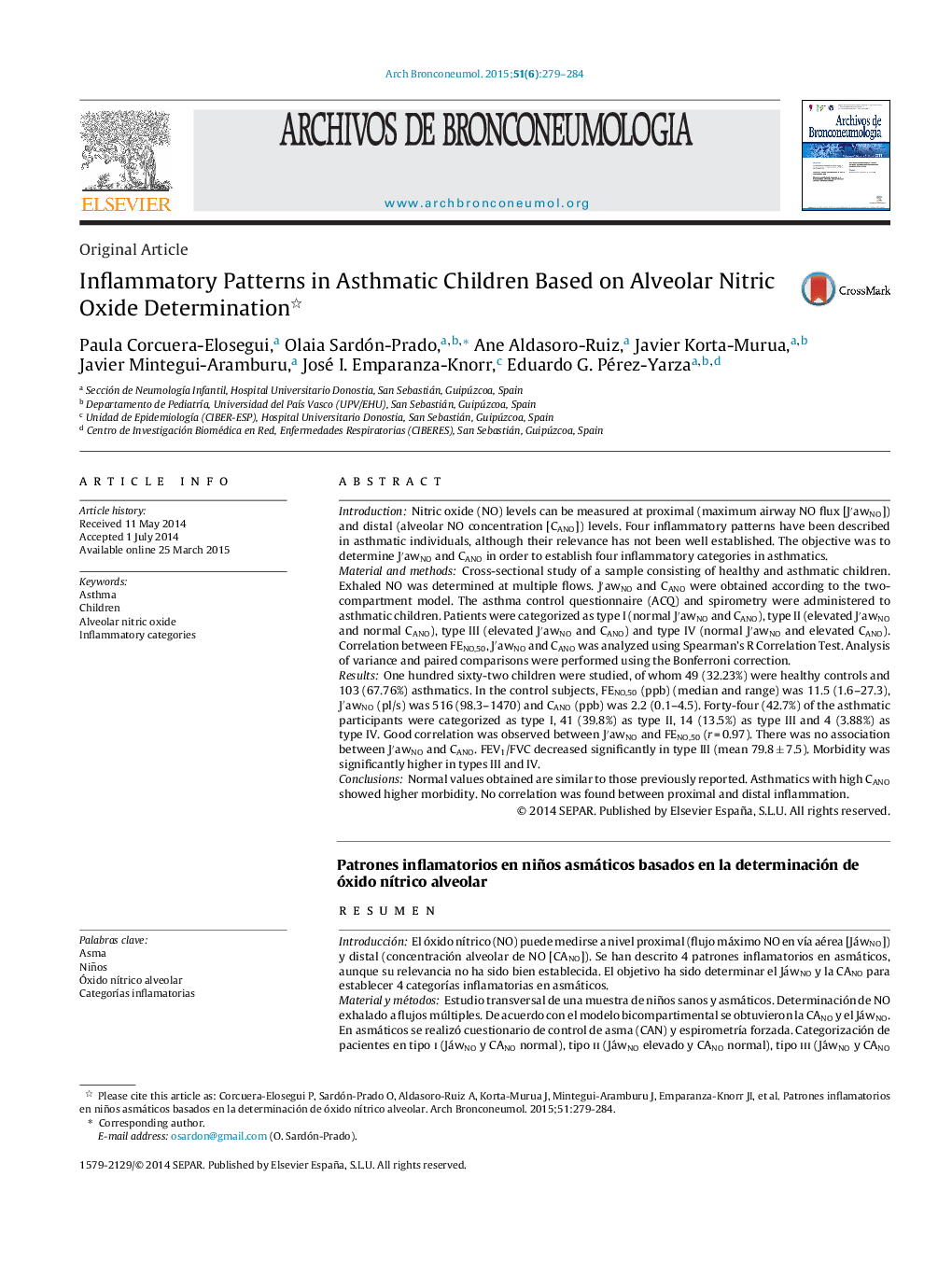| Article ID | Journal | Published Year | Pages | File Type |
|---|---|---|---|---|
| 4205461 | Archivos de Bronconeumología (English Edition) | 2015 | 6 Pages |
IntroductionNitric oxide (NO) levels can be measured at proximal (maximum airway NO flux [J′awNO]) and distal (alveolar NO concentration [CANO]) levels. Four inflammatory patterns have been described in asthmatic individuals, although their relevance has not been well established. The objective was to determine J′awNO and CANO in order to establish four inflammatory categories in asthmatics.Material and methodsCross-sectional study of a sample consisting of healthy and asthmatic children. Exhaled NO was determined at multiple flows. J′awNO and CANO were obtained according to the two-compartment model. The asthma control questionnaire (ACQ) and spirometry were administered to asthmatic children. Patients were categorized as type I (normal J′awNO and CANO), type II (elevated J′awNO and normal CANO), type III (elevated J′awNO and CANO) and type IV (normal J′awNO and elevated CANO). Correlation between FENO,50, J′awNO and CANO was analyzed using Spearman's R Correlation Test. Analysis of variance and paired comparisons were performed using the Bonferroni correction.ResultsOne hundred sixty-two children were studied, of whom 49 (32.23%) were healthy controls and 103 (67.76%) asthmatics. In the control subjects, FENO,50 (ppb) (median and range) was 11.5 (1.6–27.3), J′awNO (pl/s) was 516 (98.3–1470) and CANO (ppb) was 2.2 (0.1–4.5). Forty-four (42.7%) of the asthmatic participants were categorized as type I, 41 (39.8%) as type II, 14 (13.5%) as type III and 4 (3.88%) as type IV. Good correlation was observed between J′awNO and FENO,50 (r = 0.97). There was no association between J′awNO and CANO. FEV1/FVC decreased significantly in type III (mean 79.8 ± 7.5). Morbidity was significantly higher in types III and IV.ConclusionsNormal values obtained are similar to those previously reported. Asthmatics with high CANO showed higher morbidity. No correlation was found between proximal and distal inflammation.
ResumenIntroducciónEl óxido nítrico (NO) puede medirse a nivel proximal (flujo máximo NO en vía aérea [J́awNO]) y distal (concentración alveolar de NO [CANO]). Se han descrito 4 patrones inflamatorios en asmáticos, aunque su relevancia no ha sido bien establecida. El objetivo ha sido determinar el J́awNO y la CANO para establecer 4 categorías inflamatorias en asmáticos.Material y métodosEstudio transversal de una muestra de niños sanos y asmáticos. Determinación de NO exhalado a flujos múltiples. De acuerdo con el modelo bicompartimental se obtuvieron la CANO y el J́awNO. En asmáticos se realizó cuestionario de control de asma (CAN) y espirometría forzada. Categorización de pacientes en tipo i (J́awNO y CANO normal), tipo ii (J́awNO elevado y CANO normal), tipo iii (J́awNO y CANO elevados) y tipo iv (J́awNO normal y CANO elevado). Estudio de correlación entre FENO,50, J́awNO y CANO mediante R de Spearman. Análisis de la varianza y comparaciones pareadas, mediante corrección post hoc de Bonferroni.ResultadosSe estudiaron 162 niños: 49 (32,23%) controles sanos y 103 (67,76%) asmáticos. Se excluyeron 10 niños, 4 (2.4%) porque las determinaciones fueron incorrectas y 6 (3,7%) porque las determinaciones no siguieron el modelo lineal (valores de CANO negativos). En controles la FENO,50 (ppb) (mediana y rango) fue 11,5 (1,6–27,3), J́awNO (pl/s) 516 (98,3–1.470) y CANO (ppb) 2,2 (0,1–4,5). De los asmáticos, 44 (42,7%) se categorizaron en tipo i, 41 (39,8%) en tipo ii, 14 (13,5%%) en tipo iii y 4 (3,88%) en tipo iv. Buena correlación entre J́awNO y FENO,50 (r = 0,97). No hubo asociación entre J́awNO y CANO. Disminución significativa de FEV1/FVC en tipo iii (media 79,8 ± 7,5). La morbilidad fue significativamente superior en tipos iii y iv.ConclusionesLos valores de normalidad obtenidos son similares a los previamente publicados. Los asmáticos con CANO elevado presentaron mayor morbilidad. No hay correlación entre inflamación proximal y distal.
